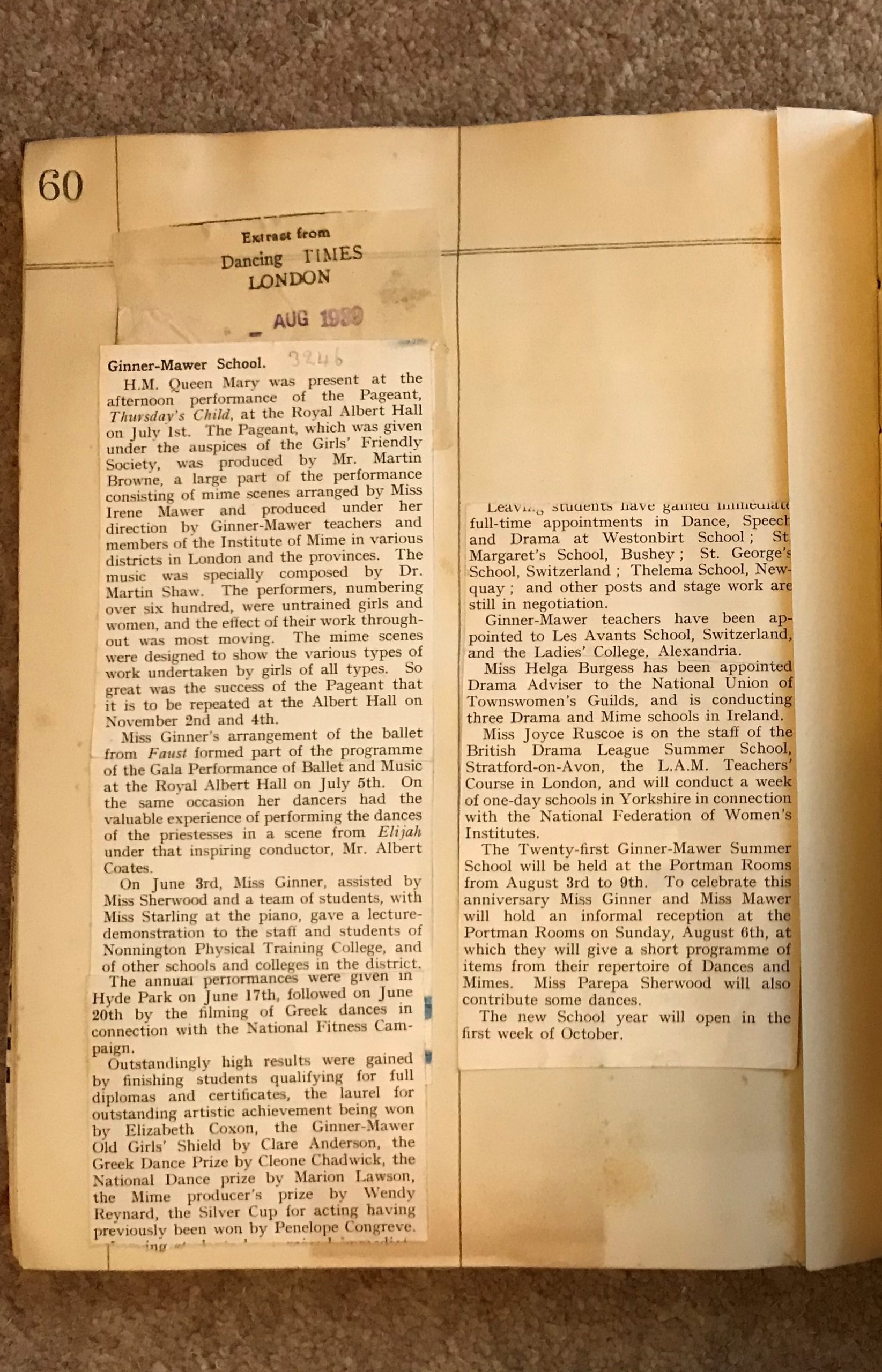Thursday’s Child (Part Four) & Other Activities Overview. August 1939
Dancing Times
This round-up of activities of the Ginner-Mawer School of Dance and Drama opens with the bold news that Her Majesty Queen Mary attended a performance which included members of the Ginner-Mawer School, at the Royal Albert Hall in London. The Queen attended as patron of the Girls’ Friendly Society, and the show was a pageant called Thursday’s Child. Royalist support and deference were strong elements of British society at the time, so I am sure that the participants would have been thrilled to perform in front of Her Majesty.
A large portion of the pageant consisted of mime scenes, over which Irene Mawer had full control. There was a huge cast – more than 600 performers, consisting of ordinary, untrained women and girls from all over England. Teachers who had been trained at Ginner-Mawer, or who were members of the Institute of Mime produced the pieces, under the direction of Miss Mawer. The mime scenes were designed to show the everyday lives of women and girls, both in the home and in their places of work.
I wonder if the women and girls were drawn from the educational work that Miss Mawer had been doing with the Women’s Institute (WI), or whether they were solely members of the Girls’ Friendly Society? As there is no mention of the WI, I am guessing that the mime teachers (through the institute of Mime) went out to their local branches of the GFS and organised the individual groups, who then all came together in London.
I feel that this work with untrained women and girls was at the heart of Irene Mawer’s intention that mime could be used as an educational tool. The performers demonstrated mime scenes showing work that they did, presumably in their everyday lives. I imagine household tasks such as brushing and mopping the floor, or work situations such as typing and filing. Perhaps feeding a baby might also have been in the scenes, or cooking. I have no evidence at all as to what the untrained girls might have done in their mimes, but I am thinking of my own training and using that to put the situation into context.
In this way, by focusing on tasks that were already familiar to the girls, they would have had a foundation on which they could easily build. The teacher could give all of the usual exercises and technique, without having to also try to get the girls to act out a role of something they might not be able to visualise and had no empathy with. This would hopefully build confidence, as well as lead to physical health and along with that, mental well-being.
The news clipping then moves on to other notable events in the School’s calendar, including a successful ballet given as part of a Gala Performance; a lecture-demonstration at Nonnington Physical Training College; the annual performance in Hyde Park; and filming of Greek dances as part of the National Fitness Campaign.
There then follows a list of Ginner-Mawer students who had successfully won a prize in school: the laurel for outstanding artistic achievement went to Elizabeth Coxon; the Ginner-Mawer Old Girls’ Shield – Clare Anderson; the Greek Dance Prize – Cleone Chadwick; the National Dance Prize – Marion Lawson; the Mime producer’s prize – Wendy Reynard; the Silver Cup for acting having previously been won by Penelope Congreve. This latter prize is interesting as I have heard discussion in the world of theatre history about the precise date that ‘acting’ as a subject was first taught in Britain. Ginner-Mawer, as far as I know, did not offer ‘acting’ as a subject, though, of course, the students were learning to act.
Of those students who had completed the course, there is a list of which schools they went on to work at: Westonbirt School; St Margaret’s School in Bushey; St George’s School in Switzerland; Thelema School in Newquay; Les Avants School in Switzerland; and the Ladies’ College in Alexandria (Egypt, I presume).
Miss Helga Burgess, who has been mentioned in my previous blog posts, was appointed Drama Adviser to the National Union of Townswomen’s Guilds. She was also due to conduct three drama and mime sessions in Ireland.
Joyce Ruscoe had been taken on as a staff member of the British Drama League Summer School in Stratford-on Avon; and also at the LAM Teachers’ Course in London; and was due to carry out a week of one-day schools in Yorkshire with the W.I. (National Federation of Women’s Institutes).
Celebrating twenty-one years of Ginner-Mawer annual summer schools, there was to be an informal party at the Portman Rooms where Miss Parepa Sherwood would also contribute some dances. (I have come across Parepa only once before, when she attended a summer school which was held at Boscastle, in Cornwall, where the School evacuated to during World War 2. Possibly she was related to Nancy Sherwood?)

